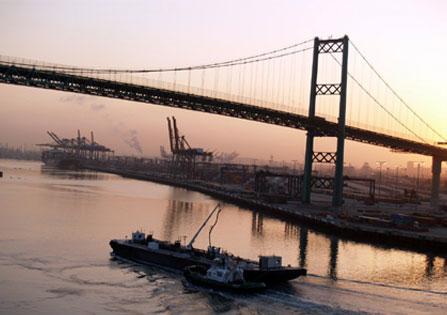forum
library
tutorial
contact

West Coast Ports Gear Up for Competition
by Bill MongelluzzoJournal of Commerce, October 6, 2009
|
the film forum library tutorial contact |

|
West Coast Ports Gear Up for Competition
by Bill MongelluzzoJournal of Commerce, October 6, 2009 |
Hoping to avoid further loss of market share when Panama Canal is widened

Having already lost about four percent of their market share of Asian cargo to Canadian and East Coast ports the past few years, and hoping to avoid a further diversion of cargo when the Panama Canal is widened in 2014, U.S. West Coast ports are jointly and individually developing strategies to be more competitive.
The game plan includes using the current trade slump as an opportunity to expand marine terminals and inland infrastructure without interfering with cargo operations. "The economic downturn is a good time to grow," Kathryn McDermott, deputy executive director of the Port of Los Angeles, told the annual Footwear Traffic Distribution and Customs conference in Huntington Beach, Calif.
Also, in what she termed an unprecedented example of regional collaboration, the executive directors of the six major West Coast container ports in August wrote a letter to the BNSF and Union Pacific railroads, urging the rail carriers to join them in branding and promoting the West Coast as the preferred gateway for trade with Asia.
The ports of Seattle, Tacoma, Portland, Oakland, Los Angeles and Long Beach are adding hundreds of acres of marine terminal space by expanding existing facilities and building new container terminals where waterfront land is available. All of the ports have excess capacity today.
Likewise, the ports, which depend upon discretionary cargo for 50 to 70 percent of their total container volume, are working with local governments and the railroads to expand inland infrastructure and connectors.
All of the West Coast ports have on-dock and near-dock rail yards that expedite the inland movement of intermodal cargo. The railroads are double-tracking their mainline routes to the Midwest and triple-tracking stretches of tracks in areas of high traffic closer to the ports in order to increase capacity and improve on-time performance.
In response to the invitation from the port directors, the railroads have met with cargo interests as well as their direct intermodal customers, the shipping lines, to discuss ways to make West Coast ports more competitive. While the rail discussions of pricing were confidential, customers indicated they were generally pleased with what the railroad executives told them, said Alex Cherin, managing director of trade relations and port operations in Long Beach.
Seattle, Tacoma, Los Angeles and Long Beach have deep harbors capable of accommodating the 8,000 to 10,000-TEU vessels that are now common in the trans-Pacific. Oakland is deepening its harbor to 50 feet.
Portland, a river port, is deepening its access channel to 43 feet from 40 feet at present, allowing it to accommodate more than 90 percent of the existing global fleet, said Barry Horowitz, a consultant to the port.
Los Angeles and Long Beach have lost cargo share since implementing clean-truck and extended gate hour fees, but now the ports are doing an about-face. Cherin said Long Beach will consider a motion to refrain from levying new fees for a yet-to-be determined number of years. Also the ports are adding so many low-emission trucks that 90 percent of all truck moves in the harbor in early 2010 will be exempt from the clean-truck fee.
Although the addition of a third set of locks will allow the Panama Canal to accommodate 10,000-TEU vessels, Horowitz said the expanded canal may affect West Coast ports "a lot less than we are led to believe."
Norfolk and Halifax are the only East Coast ports capable of accommodating fully-laden 8,000-TEU ships because they are not affected by draft limitations or bridge restrictions, he said. Also, if oil, which now sells for around $70 a barrel, should return to more than $100 a barrel, the combination of bunker fuel costs and increasing tolls at the enlarged Panama Canal could limit the growth of all-water services from Asia to the East Coast, he said.
Horowitz said fuel costs and tolls are already restraining growth at the Suez Canal, and the large debt that will be incurred in expanding the Panama Canal could cause carriers to reconsider that route. "There is a breaking point," he said.
learn more on topics covered in the film
see the video
read the script
learn the songs
discussion forum
